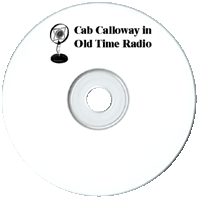

Best known for his creative vocalizations or scatting and his catchphrase "hi-de-hi-de-ho."

16 old time radio show recordings
(total playtime 5 hours, 23 min)
available in the following formats:
1 MP3 CD
or
6 Audio CDs
Text on OTRCAT.com ©2001-2026 OTRCAT INC All Rights Reserved. Reproduction is prohibited.
Cab Calloway
(1907 – 1994)

Louis Armstrong and Harry James had their trumpets, Scott Joplin and Duke Ellington had the piano, Jimmy Dorsey, Artie Shaw and Benny Goodman had the clarinet, Tommy Dorsey and Glenn Miller the trombone. Most of them could play more than one instrument, but specialized in the one they considered their own. Perhaps the greatest showman of the great Jazzmen had just his voice and a sense of "scat", the great Cab Calloway.
Cabell Calloway III was born on Christmas Day, 1907, in Rochester, New York, and grew up in the semi-affluent Sugar Hill neighborhood of Baltimore. Sugar Hill was the center of black business, cultural, and political society, not just for Baltimore but for the entire Eastern seaboard in the early years of the twentieth century. His father, Cabell Calloway, Jr., had graduated from Pennsylvania's Lincoln University and built his fortune as a lawyer and real estate investor. The younger Calloway's parents discovered he had a talent for music. They encouraged him early on by providing voice and music lessons as part of his education but expected that he would follow in Cabell Jr.'s footsteps into law and business.

While on the road, The Alabamians entered a band vs band rivalry with a group calling themselves The Missourians. The Missourians eventually came out on top, but not until Cab jumped the fence and became their leader. In 1930, the band changed their name to Cab Calloway and his Orchestra and went to try their luck in Harlem, New York City. Harlem was the Jazz capital of the world, and the hottest spot in Harlem was the Cotton club where Duke Ellington led the house band. Cab Calloway and his Orchestra were so exciting and popular that the Duke asked them to substitute for his outfit when they went on tour. Duke returned to the Cotton Club to discover that the Duke Ellington Orchestra was now the co-house band with Cab Calloway and his Orchestra. NBC broadcast a remote twice weekly from the Cotton Club, and Cab and his Orchestra were also featured on Walter Winchell's program and played on Bing Crosby's show from the Paramount. These broadcasts helped Cab and the Duke to shatter the network's color barrier.

Between The Cotton Club gig, Hollywood, and touring, Cab Calloway and his Orchestra became one of the busiest acts in the country. Rather than deal with Jim Crow attitudes when traveling through the South, Calloway was successful enough that he could afford to hire a private railway car for the band. His scat improvisations, vaudeville sense of showmanship, and white tuxedo stylings made him incredibly popular with audiences. In 1944, he published The New Cab Calloway Hepster's Dictionary: The Language of Jive, which attempted to capture the patois of Harlem for curious outsiders. He even developed a precursor to Michael Jackson's "Moonwalk" dance move called "the Buzz" decades before the King of Pop was born.
Cab appeared in the 1952 European touring production of Porgy and Bess. He was featured in the Blues Brothers (1980) and performed a white tuxedo rendition of Minnie the Moocher. He suffered a stroke in June 1994 and died five months later on November 18, 1994. He was 86.
Text on OTRCAT.com ©2001-2026 OTRCAT INC All Rights Reserved. Reproduction is prohibited.
You have reached the maximum number of votes for a unregistered user.
Please login or create a new account to continue...
You have reached the maximum number to down votes in this page.



Cab Calloway Disc A001
|
Add Audio CD to Cart - $5.00 |
Cab Calloway Disc A002
|
Add Audio CD to Cart - $5.00 |
Cab Calloway Disc A003
|
Add Audio CD to Cart - $5.00 |
Cab Calloway Disc A004
|
Add Audio CD to Cart - $5.00 |
Cab Calloway Disc A005
|
Add Audio CD to Cart - $5.00 |
Cab Calloway Disc A006
|
Add Audio CD to Cart - $5.00 |
Please wait...
COMMENTS
Be the first to comment on "Cab Calloway"
Leave a comment